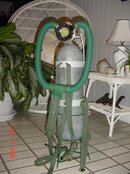DevonDiver
N/A
SOME skills, sure. But can you tell me how I am endangering myself or others by learning the frog kick on my own? You can't bundle all skills together like that, it's crazy.
I wasn't aware there was a 'Frog kick' C-Card? lol
In the context of 'courses'....the Frog kick is taught as one option of propulsion for environments where restricted space, overhead environment and high silt may cause extreme danger due to silt-out and loss of direction (exit).
In this context...the skill becomes very different to self-teaching yourself in a cosy reef environment. The skill requires deft movements, control and judgement.
It is also part of a greater 'skill'...choosing the optimum propulsion method for any given environment/situation. The over-arching skill being...to propel yourself through an environment without causing danger via silt out.
If, as a recreational diver, you want to watch some you-tube of people frog-kicking...and then start replicating that on your reef dives...then that is fine. Many people enjoy frog kick as a leisurely way to tour a reef.
But does that mean you can 'Frog kick'...in the situations that the skill was intended to be used in? Are you now an expert 'Frog-kicker'?





